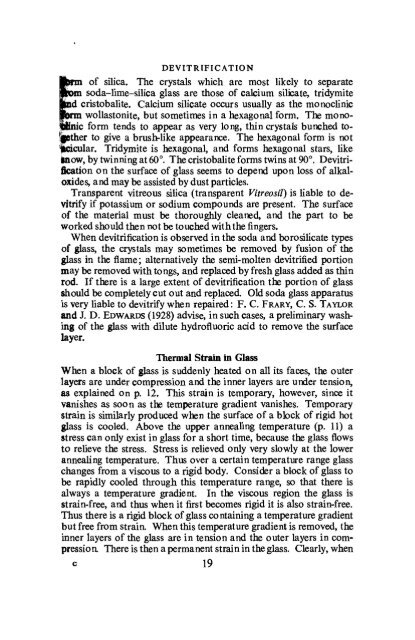Laboratory Glass-Working for Scientists - Sciencemadness Dot Org
Laboratory Glass-Working for Scientists - Sciencemadness Dot Org
Laboratory Glass-Working for Scientists - Sciencemadness Dot Org
Create successful ePaper yourself
Turn your PDF publications into a flip-book with our unique Google optimized e-Paper software.
I<br />
DEVITRIFICATION<br />
of silica. The crystals which are most likely to separate<br />
soda-lime-silica glass are those of calcium silicate, tridymite<br />
id cristobalite. Calcium silicate occurs usually as the monoclinic<br />
inn wollastonite, but sometimes in a hexagonal <strong>for</strong>m. The monoic<br />
<strong>for</strong>m tends to appear as very long, thin crystals bunched tolgBther<br />
to give a brush-like appearance. The hexagonal <strong>for</strong>m is not<br />
pcicular. Tridymite is hexagonal, and <strong>for</strong>ms hexagonal stars, like<br />
mow, by twinning at 60°. The cristobalite <strong>for</strong>ms twins at 90°. Devitrification<br />
on the surface of glass seems to depend upon loss of alkaloxides,<br />
and may be assisted by dust particles.<br />
Transparent vitreous silica (transparent Vitreosil) is liable to devitrify<br />
if potassium or sodium compounds are present. The surface<br />
of the material must be thoroughly cleaned, and the part to be<br />
worked should then not be touched with the fingers.<br />
When devitrification is observed in the soda and borosilicate types<br />
of glass, the crystals may sometimes be removed by fusion of the<br />
glass in the flame; alternatively the semi-molten devitrified portion<br />
may be removed with tongs, and replaced by fresh glass added as thin<br />
rod. If there is a large extent of devitrification the portion of glass<br />
should be completely cut out and replaced. Old soda glass apparatus<br />
is very liable to devitrify when repaired: F. C. FRARY, C. S. TAYLOR<br />
and J. D. EDWARDS (1928) advise, in such cases, a preliminary washing<br />
of the glass with dilute hydrofluoric acid to remove the surface<br />
layer.<br />
Thermal Strain in <strong>Glass</strong><br />
When a block of glass is suddenly heated on all its faces, the outer<br />
layers are under compression and the inner layers are under tension,<br />
as explained on p. 12. This strain is temporary, however, since it<br />
vanishes as soon as the temperature gradient vanishes. Temporary<br />
strain is similarly produced when the surface of a block of rigid hot<br />
glass is cooled. Above the upper annealing temperature (p. 11) a<br />
stress can only exist in glass <strong>for</strong> a short time, because the glass flows<br />
to relieve the stress. Stress is relieved only very slowly at the lower<br />
annealing temperature. Thus over a certain temperature range glass<br />
changes from a viscous to a rigid body. Consider a block of glass to<br />
be rapidly cooled through this temperature range, so that there is<br />
always a temperature gradient. In the viscous region the glass is<br />
strain-free, and thus when it first becomes rigid it is also strain-free.<br />
Thus there is a rigid block of glass containing a temperature gradient<br />
but free from strain. When this temperature gradient is removed, the<br />
inner layers of the glass are in tension and the outer layers in compression.<br />
There is then a permanent strain in the glass. Clearly, when<br />
c 19
















